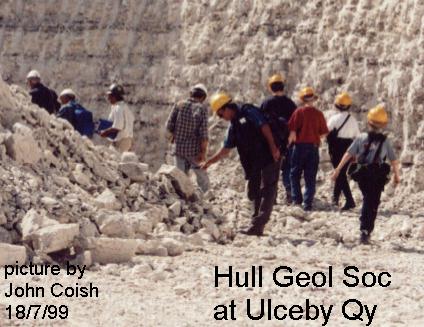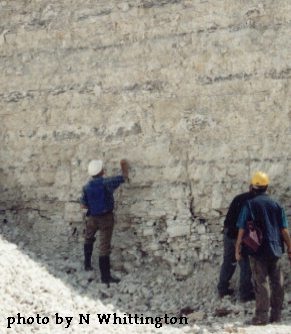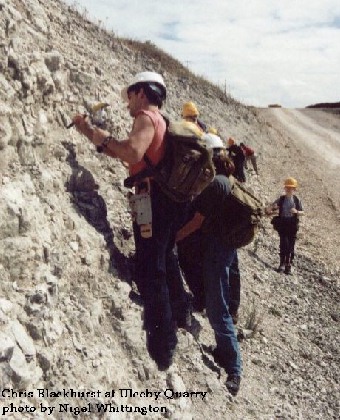

Humberside Geologist No. 13
Report of Field Meeting in North Lincolnshire, Sunday 18th July 1999.
Leader: Paul Hildreth
22 members and friends of the society assembled at the entrance to Ulceby Vale Quarry (TA 104133) at 10.15am where the purpose of the meeting, a look at the lithostratigraphy of the Chalk, was described by the leader. An itinerary and guide to the location of sites to be visited was distributed. This included a section inviting participants to take part in a friendly fossil collection competition but points did not mean prizes.

At Ulceby Vale recent deepening of the section revealed beds belonging to the Burnham Chalk Formation (Turonian - Sternotaxis plana zone). The lower part of the quarry exposed a sequence of white and yellowish chalk containing flint bands several of which are carious. At one level, paramoudra flints were evident; these represent enormous burrow structures. Other interesting features of this section included ‘rafts’ of Inoceramus sp., some of which are incorporated within the masses of flint, cross sections of the zone fossil and poorly preserved sponges.

The Ulceby Marl was noted in the face of the quarry above the flint bands marking a change in general chalk lithology. Vale House Quarry, which is now back-filled and on an adjacent site, was the type locality of the Ulceby Marl and Ulceby Oyster Bed. Both were examined by members of the group. The Ulceby Marl is one of several marl bands within the Chalk of the Northern Province which has proved to contain volcanic ash and can be traced successfully into Saxony in Germany. The Ulceby Oyster Bed could be traced around the northern face of the quarry where inclined plant-access tracks bring it to working level. A rich fauna (for the Chalk!) is present including terebratulid and rhynchonellid brachiopods as well as ‘oysters’.

The party was not able to visit Burnham Lodge Quarry, type-section for the junction between Welton and Burnham Formations, as the landowner proved to be uncooperative. The type-section of the Deepdale Flint and Marls of the Welton Chalk (Turonian - Terebratulina lata zone) was the next stop on the itinerary (TA 045182). This is a small quarry (Deepdale Pit) owned by Singleton-Birch. The two marls were well exposed in the southern face and members were encouraged to examine the more fossiliferous, laminated chalk below the Deepdale Flint. Those used to working with more productive formations found the term ‘more fossiliferous’ amusing!
Several members lunched at the Cross Keys public house in Grasby (TA 088050) en route to the large working quarry at Mansgate Hill just south of Caistor (TA 123002), the venue for the afternoon. The party worked its way down the succeccssion from Welton Chalk beds containing the Grasby Flint (Turonian - Terbratulina lata zone) through the '‘brashy', inoceramid-debris-rich and sub-flint-bearing beds of the Mytiloides labiatus zone. The lowest beds of the Welton Chalk show a distinctive change in lithology consisting of 50cm of variegated claystone, siltstone and marl. The leader demonstrated how these beds (Turonian - Metoicoceras geslineanum zone) can be prepared to reveal several distinguishable units including the Black Band and members were occupied in searching these for fish scales and teeth. Some members were very successful. Interested readers may refer to the leader’s contribution in Humberside Geologist (1999; 12, 18-30).
The group continued its journey down the Chalk succession into the Ferriby Chalk (Cenomanian - Holaster trecensis zone), briefly noting the Nettleton Stone and basal oyster bed, ending at the level of the Totternhoe Stone or Grey Bed (Cenomanian - Holaster subglobosus zone). This is another fossil-rich and important marker band, about 90cm thick, where members collected a varied fauna of brachiopods, worm burrows, fish remains and the very attractive bivalve Entolium orbiculare (J. Sowerby). A specimen of the large ammonite Parapuzosia was recognised towards the top of the Totternhoe Stone but recovery proved too difficult.
The President thanked the leader for an interesting and successful day expressing some mild surprise that the Chalk could be a satisfying medium for a full day’s study.
(c) Hull Geological Society 1999 + 2007
copyright Hull Geological Society 2020